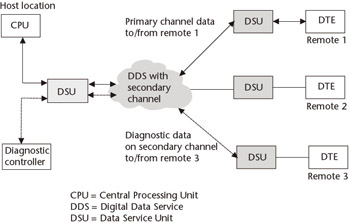9.2 Digital Data Services
|
| < Day Day Up > |
|
As its name implies, DDSs provide digital communication circuits and support speeds up to 56 Kbps for point-to-point or multipoint applications. As a private-line interoffice service, DDS may be provisioned as a hub-based service and is available in point-to-point and multipoint synchronous configurations. With hub-oriented services, the user’s traffic must be routed through a series of special hub offices. Table 9.1 summarizes the primary and secondary channel bit rates.
| Primary Channel | Secondary Channel |
|---|---|
| 2.4 Kbps | 133 bps |
| 4.8 Kbps | 266 bps |
| 9.6 Kbps | 533 bps |
| 19.2 Kbps | 1,066 bps |
| 56 Kbps | 2,132 bps |
| 64 Kbps | Not available |
Optionally, DDS with a secondary channel (DDS/SC) may be provided to the customer. The secondary channel operates at a relatively low bit rate and is typically used to measure the end-to-end error-rate performance of the primary channel. DDS equipment also uses the secondary channel to provide remote unit configuration, surveillance of the remote DSU or terminal interface, remote alarming, performance testing of the network and equipment, and reporting of reference information resident in the firmware of each remote CSU/DSU.
In providing a completely independent, low-speed (auxiliary) data channel, DDS/SC allows network surveillance to be performed on a continuous and nondisruptive basis over the secondary channel (see Figure 9.2), without interfering with the production data, which continues to flow over the primary channel.

Figure 9.2: An application of DDS/SC. The secondary channel provides the means through which the diagnostic controller can poll location 3. At the same time, the host, using the primary channel, may poll location 1 for normal production data.
While there are CSU-DSUs that provide a virtual secondary channel on conventional DDS circuits, by multiplexing test data along with user data, these devices do not provide the testing flexibility of DDS/SC. Since the primary and secondary channels derived with this approach are not truly independent, continuous, real-time tests cannot be performed without impacting production data.
Both the CSU and DSU fall into the category of CPE. Because of the complementary functional relationship of the CSU and DSU when used with DDS, most vendors have integrated the two devices into a single unit, which is sometimes called a “digital data set” (see Figure 9.3). While the CSU and DSU elements can be provided separately for DDS, the more cost-effective approach is to integrate both functions into one unit. Almost all new DDS circuits are terminated in an integrated CSU-DSU device.

Figure 9.3: An integrated CSU-DSU on a DDS circuit.
|
| < Day Day Up > |
|
EAN: 2147483647
Pages: 184